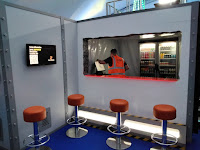Previously I'd only been along as an attendee but this time I signed up for volunteering at set-up and tear-down so spent a week on-site.
This proved to be a great experience as it was a bunch of days working with like-minded people to build something for others to enjoy, which aligns pretty much with all the stuff I do at LARP.
The area I was working in was 'Cybar', a nightclub/art installation built from nothing inside a huge saddlespan tent in a field.
The theme was an 'undersea research facility' and for this there were a lot of fake strips and bolts for the 'inside of a battleship' look. The bolt heads were all 3D printed and I ran my printers for a bit to contribute various 3D printed greebles to the pile that got screwed to the walls.We had a bar serving drinks and each room had fake pressure doors with screens showing into other areas with animations that other people involved in the project had made.
We had 38 'MoD boxes' which were old intercom switch units of various types from Ministry of Defence Landrovers I stripped, cleaned, sprayed and fitted with new labels covered in technobabble.
Not a complicated job but a long and dirty one. The switches have an amazing tactile quality to them and people loved flicking them even though they had absolutely no effect.
There were also the Infopoints, fake industrial display units showing detail about the contents of each room.These were designed by Charles Yarnold, the main Cybar creative lead, with a custom PCB from Graham Sutherland that uses an ESP32 to drive an LED logo, some neopixels in a ring and a new-old-stock 'flat' CRT that would have originally been fitted to a door intercom system.
For these I wrote the code that dragged the info from GitHub, along with some other settings and displayed the text on the CRT in a faux-retro-terminal kind of way.
While not desperately complicated, I was pleased with how the animation worked and that their behaviour was 'robust'. The data was stored in a JSON that I also wrote to flash and compared at regular intervals for changes so they were easily updateable but would survive a loss of connectivity.
Unusually for an ESP32 WiFi project they also needed to connect to the WPA2-Enterprise WiFi at EMFCamp which is a bit of an edge case I've never used before. Being EMFCamp I was vaguely worried about attacks against the device even on the 'outbound only' WiFi so they stayed disconnected most of the time and validated the server certificate when connecting to GitHub.
This all worked quite nicely and I really ought to do a separate blog post about it as while each element is small it worked nicely together.
I'd really like to get involved at next EMFCamp and maybe bring something of my own to it as an installation or part of the set. I had a couple of ideas pop into my head as we got close, but simply no time left to do them. Early on I wasn't sure about boundaries/theme for them but now I've done one event I think I'd feel much happier about picking something that would fit in and work.



3 comments:
Thanks for the background about your work on null sector.
Whilst at the event, I particularly liked the infopoints.
Monochrome CRT monitors seem to be a very good fit for future dystopia. :-)
What happens/happened to all this stuff now?
Please don't say it just went in a skip...
Any chance of buying one of the MoD boxes or infopoints?
Who would I need to talk to?
This all went into storage for future use.
Yay, glad to hear that the stuff will get more use.
Post a Comment